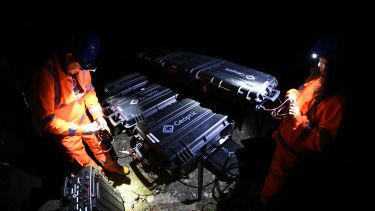Tunnel vision: Using cosmic rays to safely inspect railways
There are hundreds of underground railway tunnels in the UK, but inspecting them requires sending down a team of operators into often unpleasant conditions. Research by Professor Lee Thompson is at the heart of Geoptic; a spinout that uses patented technology to examine tunnels and locate voids.

The Victorian era saw a boom of technological advances that shaped Britain’s railway landscape into what it is today. The industrialisation of the 1840s grew the railway network rapidly, allowing millions of passengers to enjoy new opportunities for travel through reduced journey times between cities and villages.
The growth of the railway network accelerated the construction of hundreds of underground train tunnels. Traditionally, workers built tunnels by digging at either opening of the tunnel and meeting in the middle. But to improve access and reduce construction times Victorian workers often excavated vertical shafts along the length of the tunnel.
Many of these construction shafts have since been sealed and bricked over making them difficult to locate. These hidden shafts may pose potential risks to longstanding train infrastructure and finding them can be a difficult task.
Today, railway tunnels are inspected manually as part of a maintenance routine by qualified operators to ensure that structures are safe and in good order. This process may require an individual and machinery to be in physical contact with tunnel walls while facing uncomfortable conditions such as a lack of light and high levels of dust.
Geoptic, a collaborative spin-out company from the University of Sheffield, the University of Durham, and St Mary’s University, Twickenham, has developed a solution to provide valuable tunnel information without the need for invasive investigations.
Current methods for confirming the presence of hidden shafts in railway tunnels involve drilling into the tunnel lining which requires a large team of people to work in challenging conditions. Our patented method measures the rate of muons at different points along the tunnel to give a picture of the density changes in the overburden" explains Lee Thompson, Professor of Experimental Particle Physics at the University of Sheffield and Technical Director at Geoptic.
Muon tomography: how nature’s x-rays work
Tomography is the term used to describe a technique of viewing a cross-section of a solid object using x-rays or an ultrasound.
A muon is a particle that is 200 times heavier than an electron. The additional mass allows it to penetrate through hundreds of metres of materials including brick and concrete.
Cosmic ray muons are created in the atmosphere when so-called primary cosmic ray particles, which are created primarily in our own Sun and Galaxy, interact with the Earth's atmosphere. There are around 10,000 cosmic ray muons passing through each square metre of the ground every minute.
Similar to an x-ray, muon tomography is the process of monitoring how many muon particles are absorbed as they pass through an area of interest. Using a muon detector, this process can reveal the density of a material and identify any voids.
Our instruments detect the naturally occurring cosmic ray muons after they have passed through an object of interest. Where there is more material, more of the muons are absorbed and where there is less material, fewer are absorbed. Via a process which is similar to how medical X-rays are used to identify density variations in materials, by counting the number of muons we are able to understand density differences in the object being studied
Professor Lee Thompson
Professor of Experimental Particle Physics at the University of Sheffield
In 2017 muon tomography was used to examine the Great Pyramid at Giza leading to the discovery of a hidden secret chamber. This form of technology has also been used to study magma chambers inside active volcanoes and nuclear reactors.
Award-winning imaging
Founded in 2019 by Dr Chris Steer, Professor Lee Thompson, Dr Patrick Stowell and Professor Jon Gluyas, Geoptic combines years of experience in nuclear and particle physics instrumentation, advanced data analytics and geophysics.
The spin-out offers non-intrusive imaging technologies to help organisations understand the internal condition of large structures and tunnels.
To date, Geoptic has applied this technology to railway tunnels to tackle industrial engineering diagnostic problems and locate hidden voids.
In 2020, Geoptic received the national Institute of Physics (IOP) Business Award. The IOP’s prestigious Business Awards are unique in the UK and Ireland in recognising the significant contribution that physicists and physics make in industry.
In 2022 the spin-out won an award for Innovation in Instrumentation & Monitoring at the New Civil Engineer Tunnelling Festival. The spin-out has also won the 2022 New Civil Engineer TechFest award for Innovation Incubator.
“Our patented technology is also promising outside of the railway sector in areas such as construction, mining and nuclear waste. The idea of being able to get an image of something without having to affect it in any way can be applied to a breadth of industries as muon tomography is capable of detecting density changes in many materials” says Professor Lee Thompson.
Written by Alina Moore, Research Communications Coordinator

